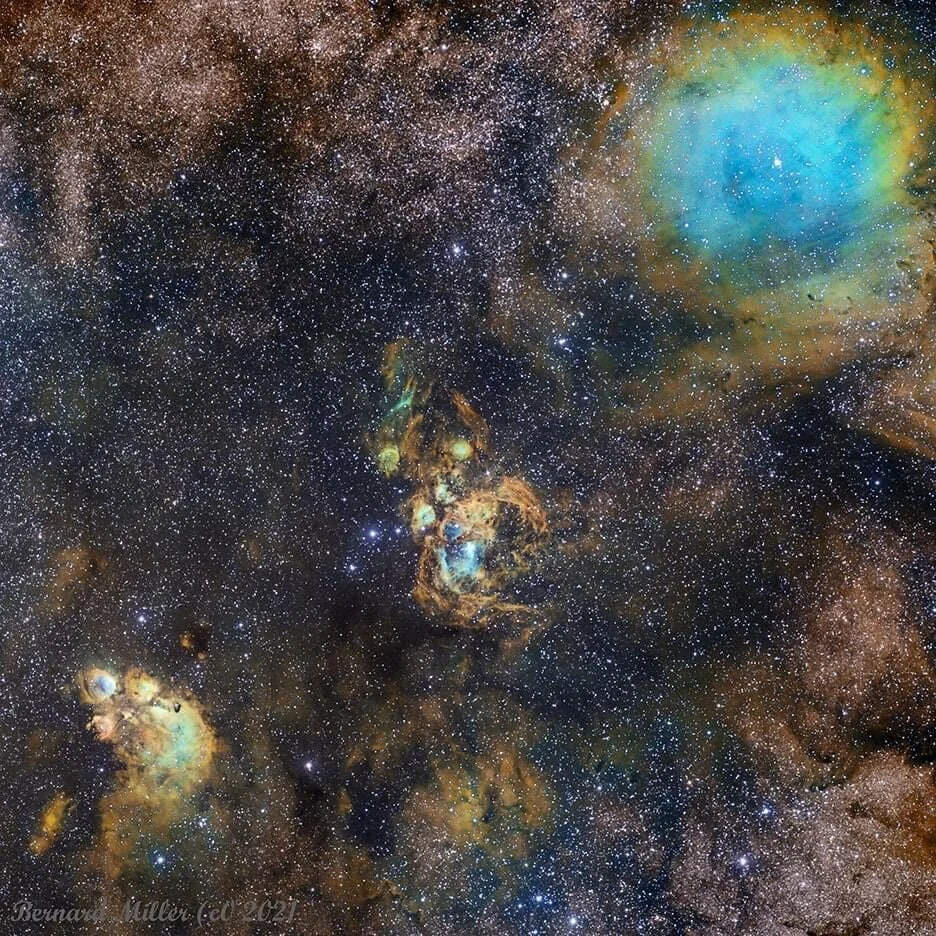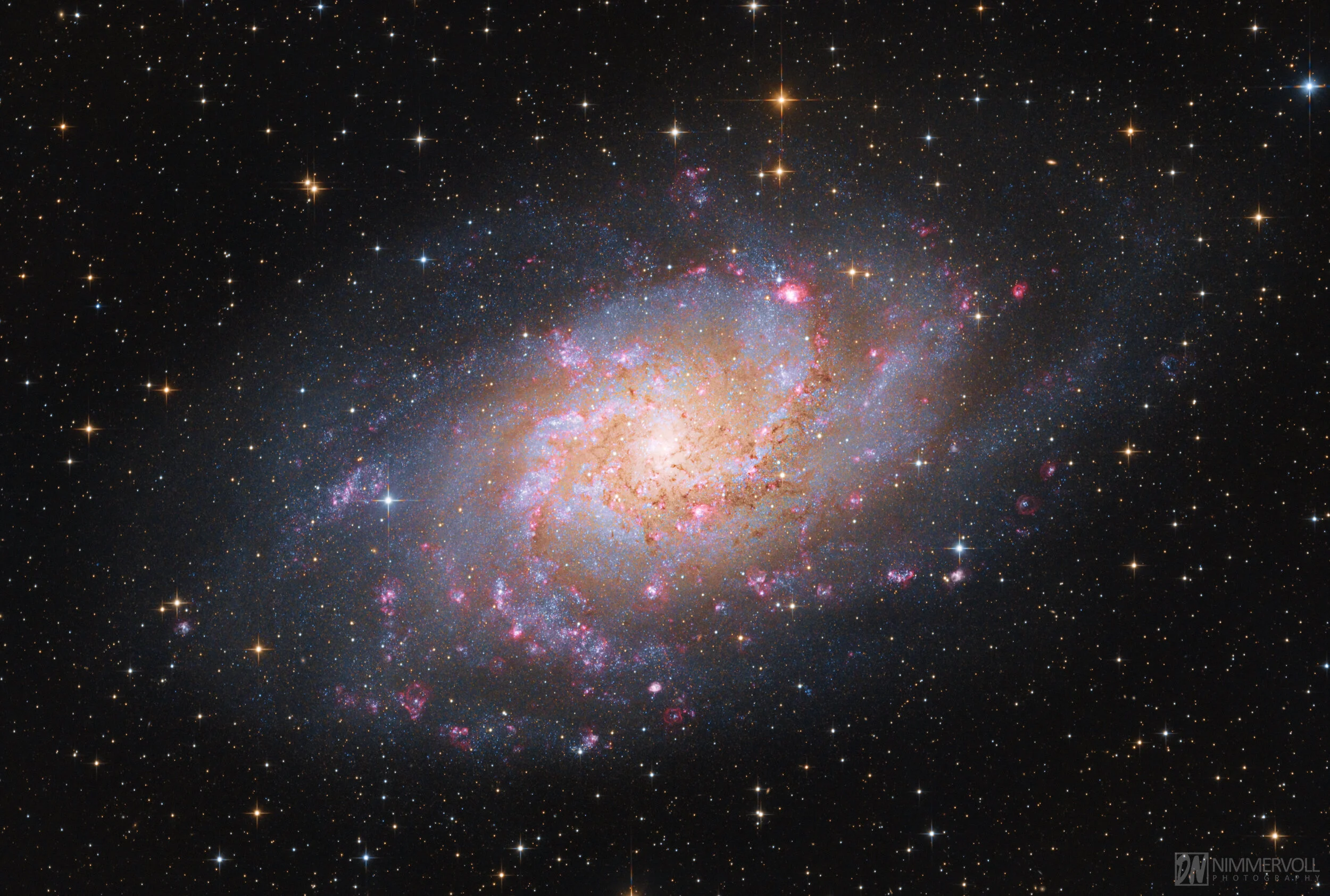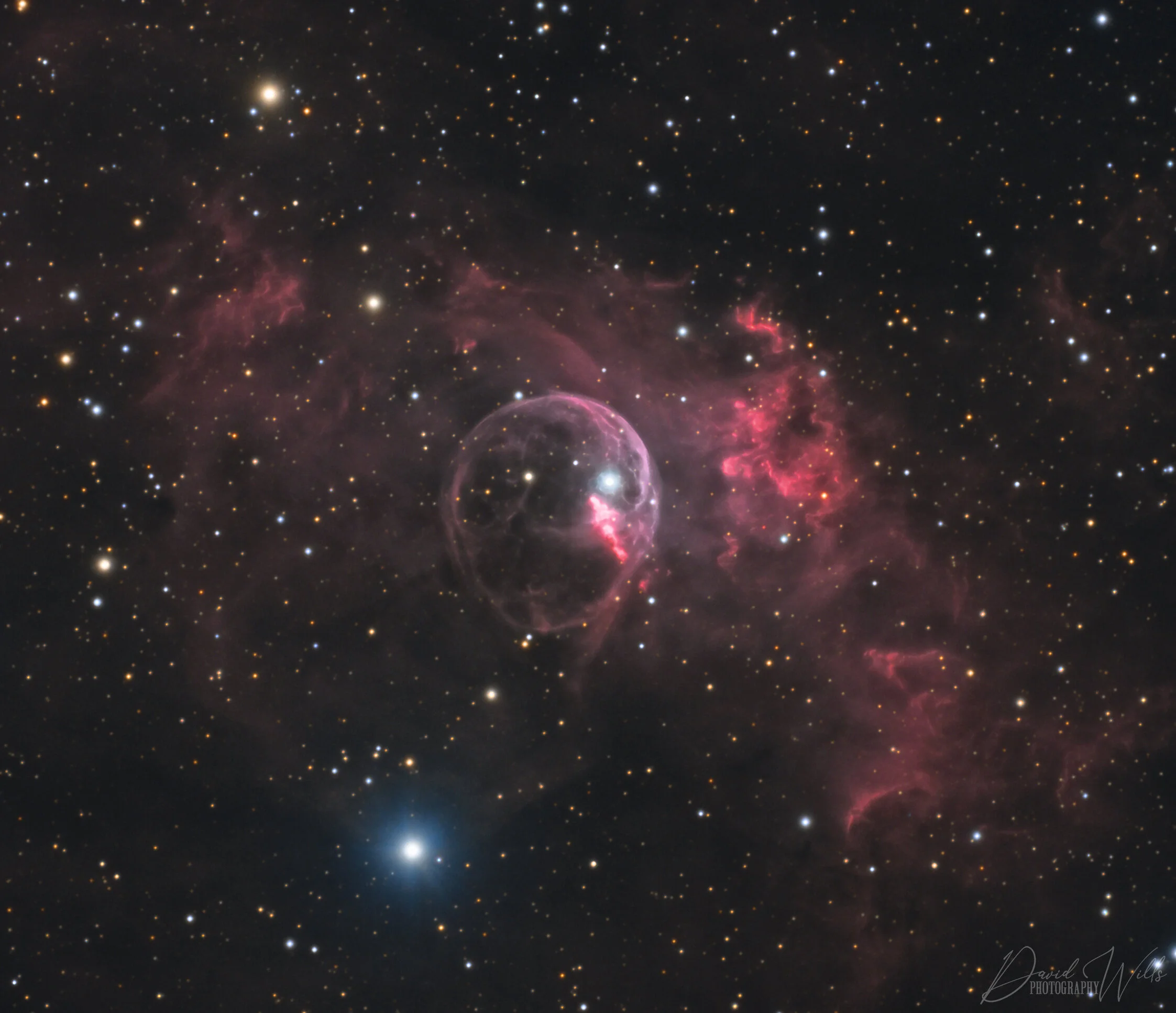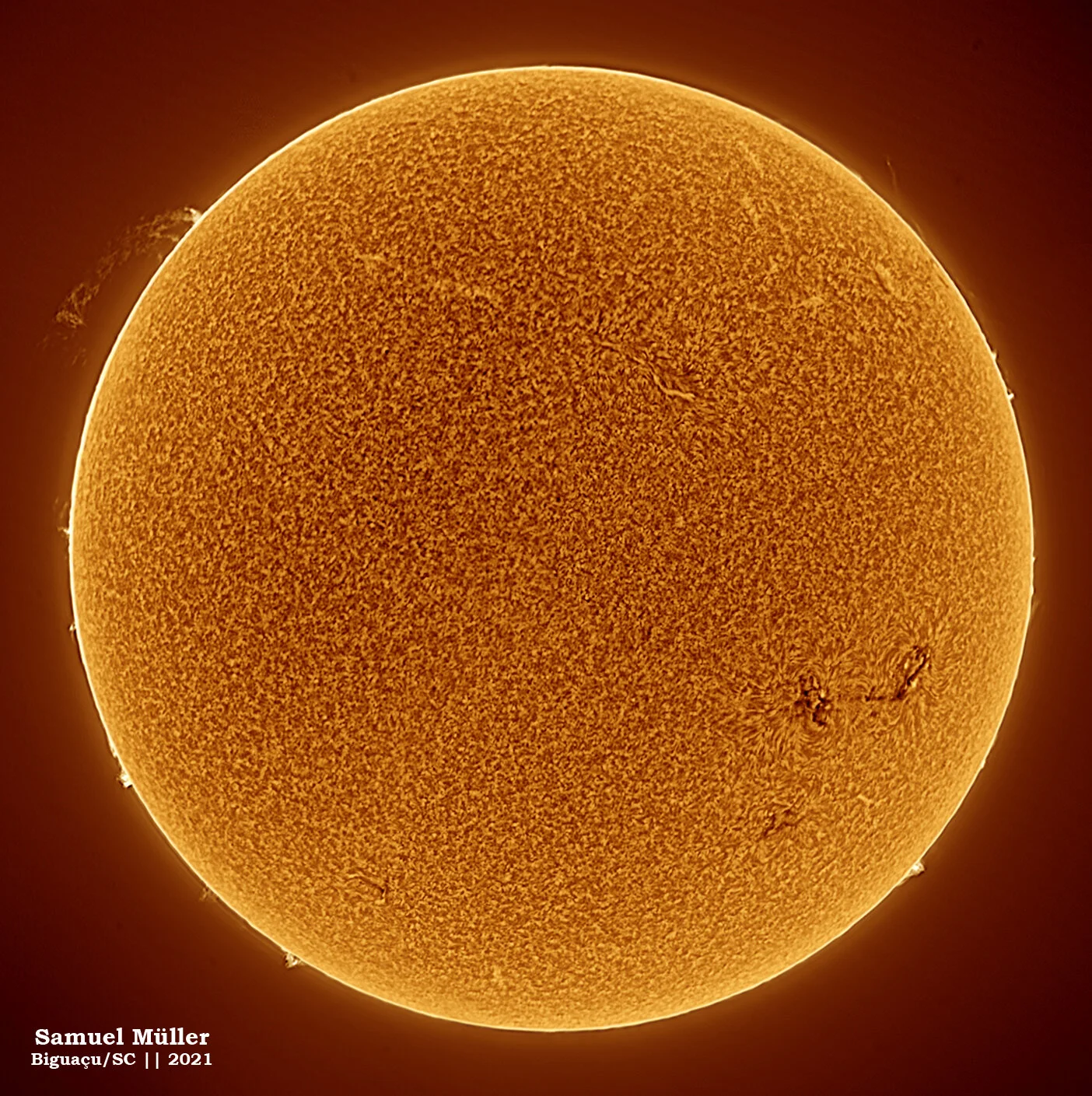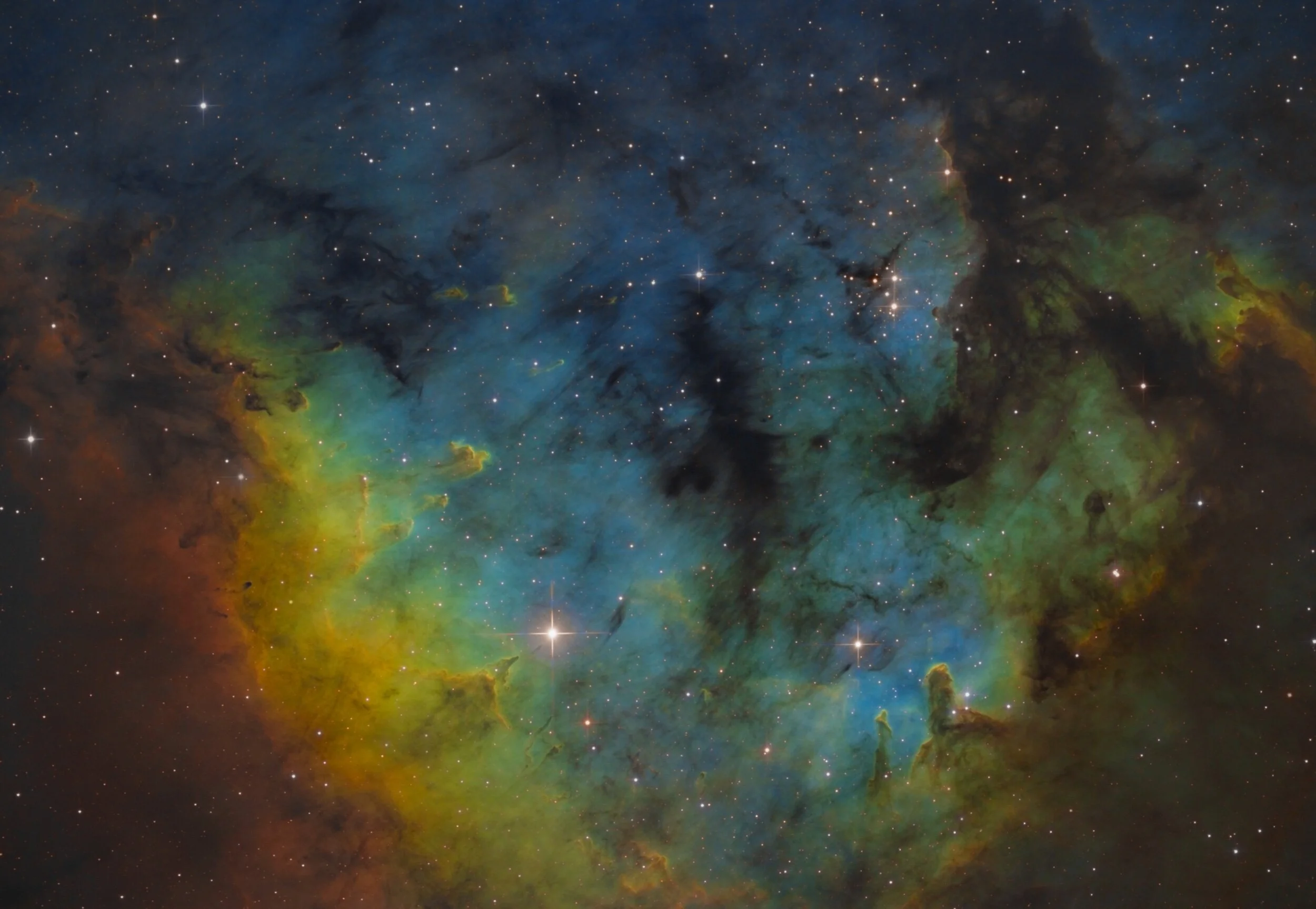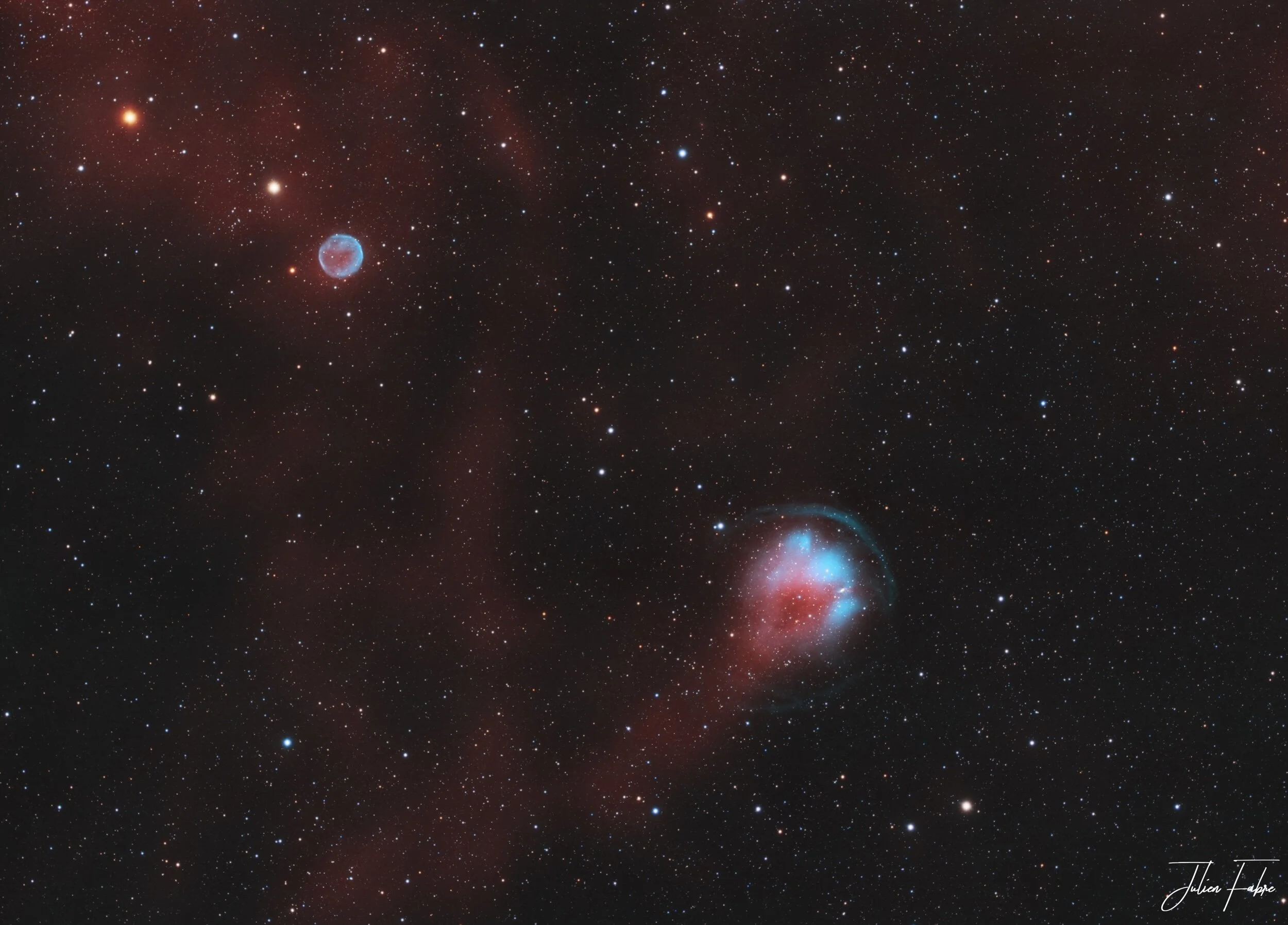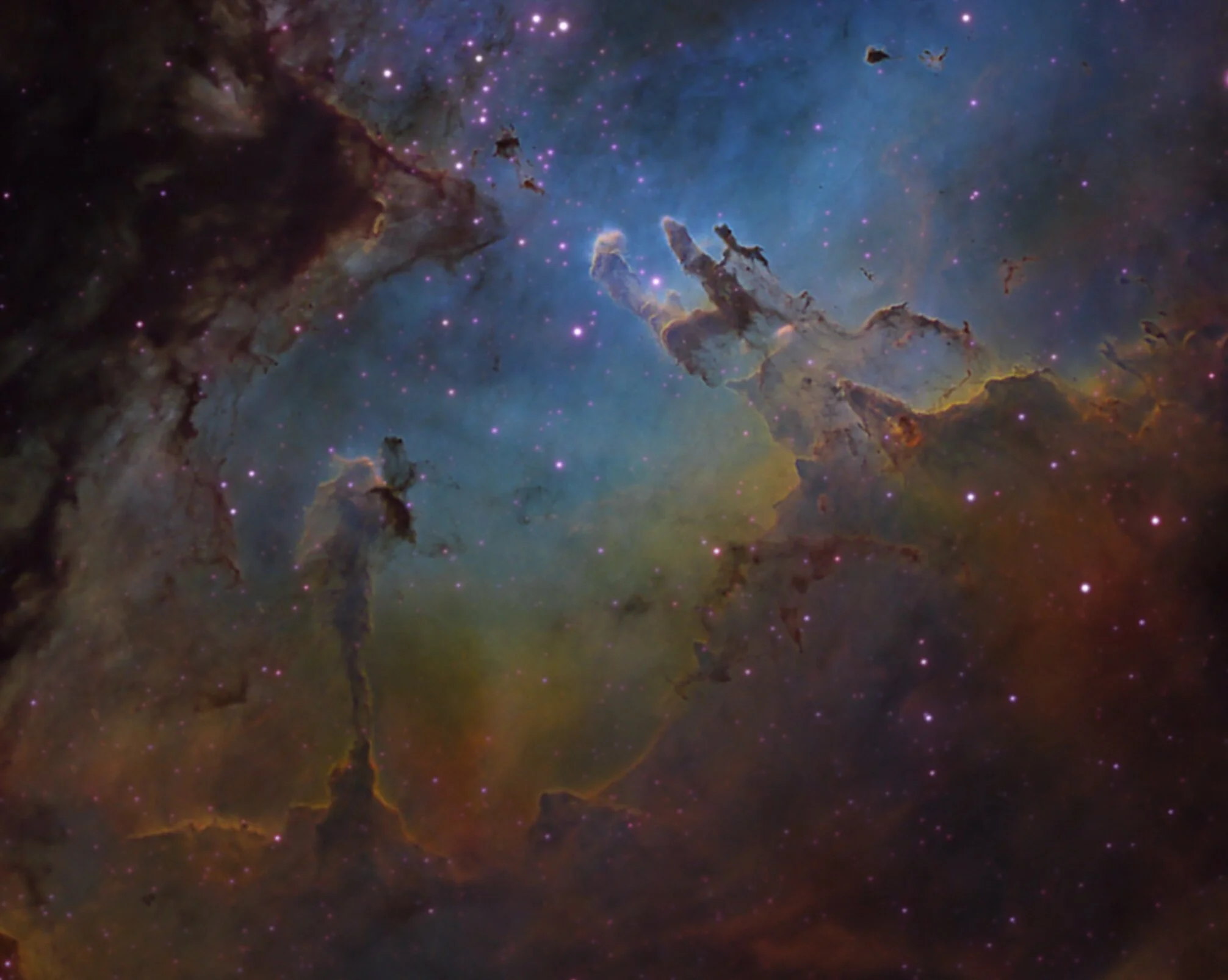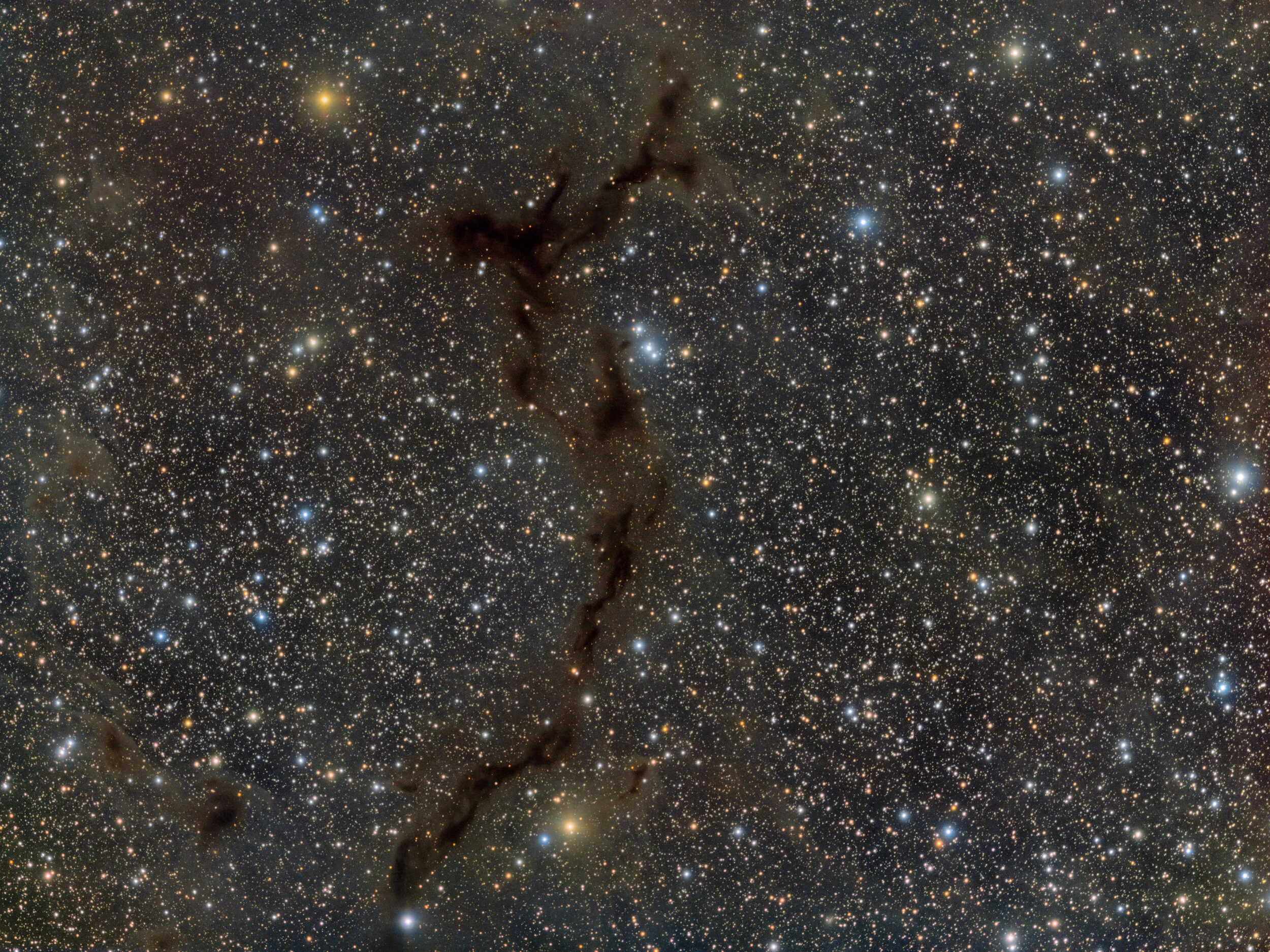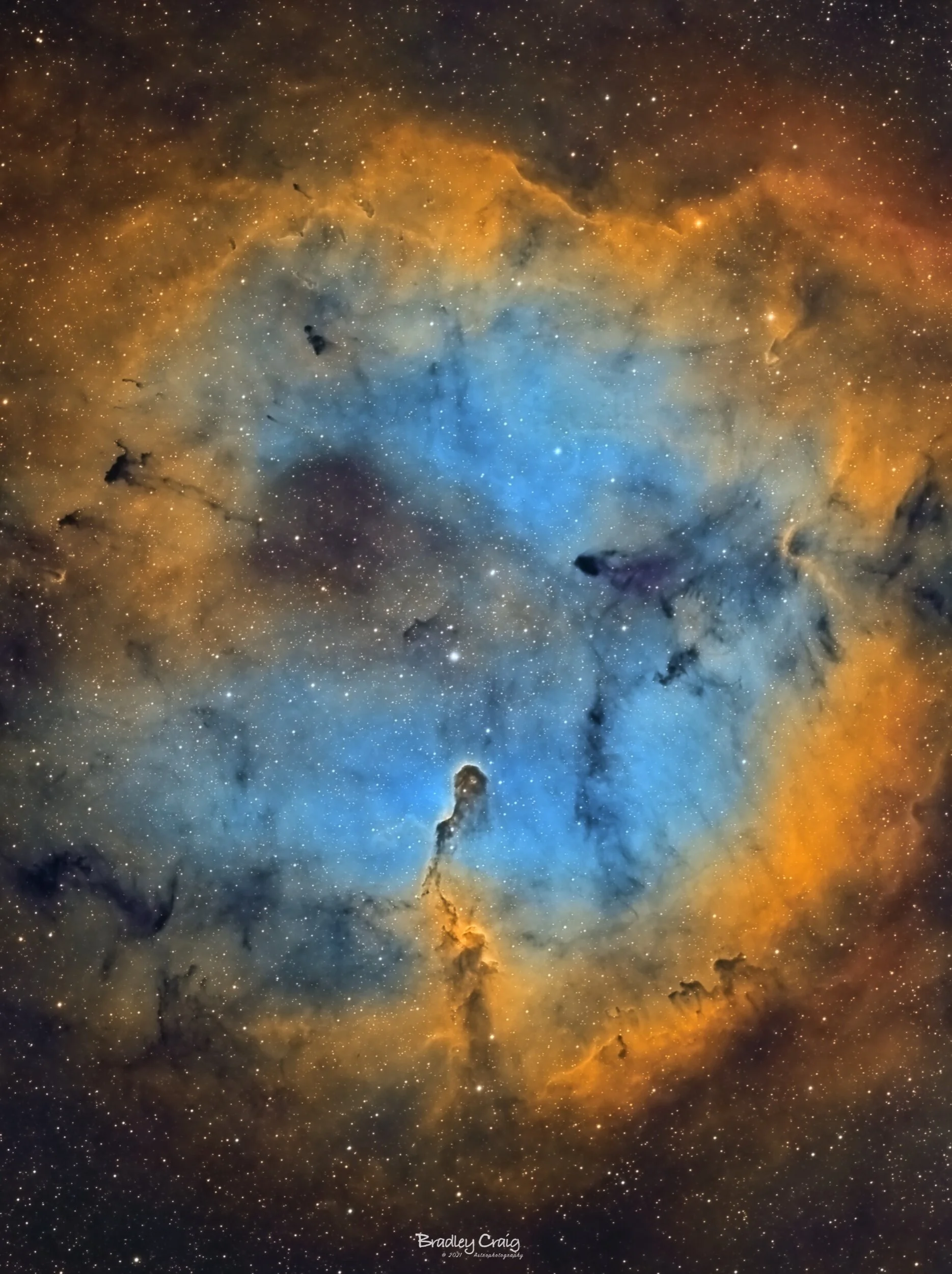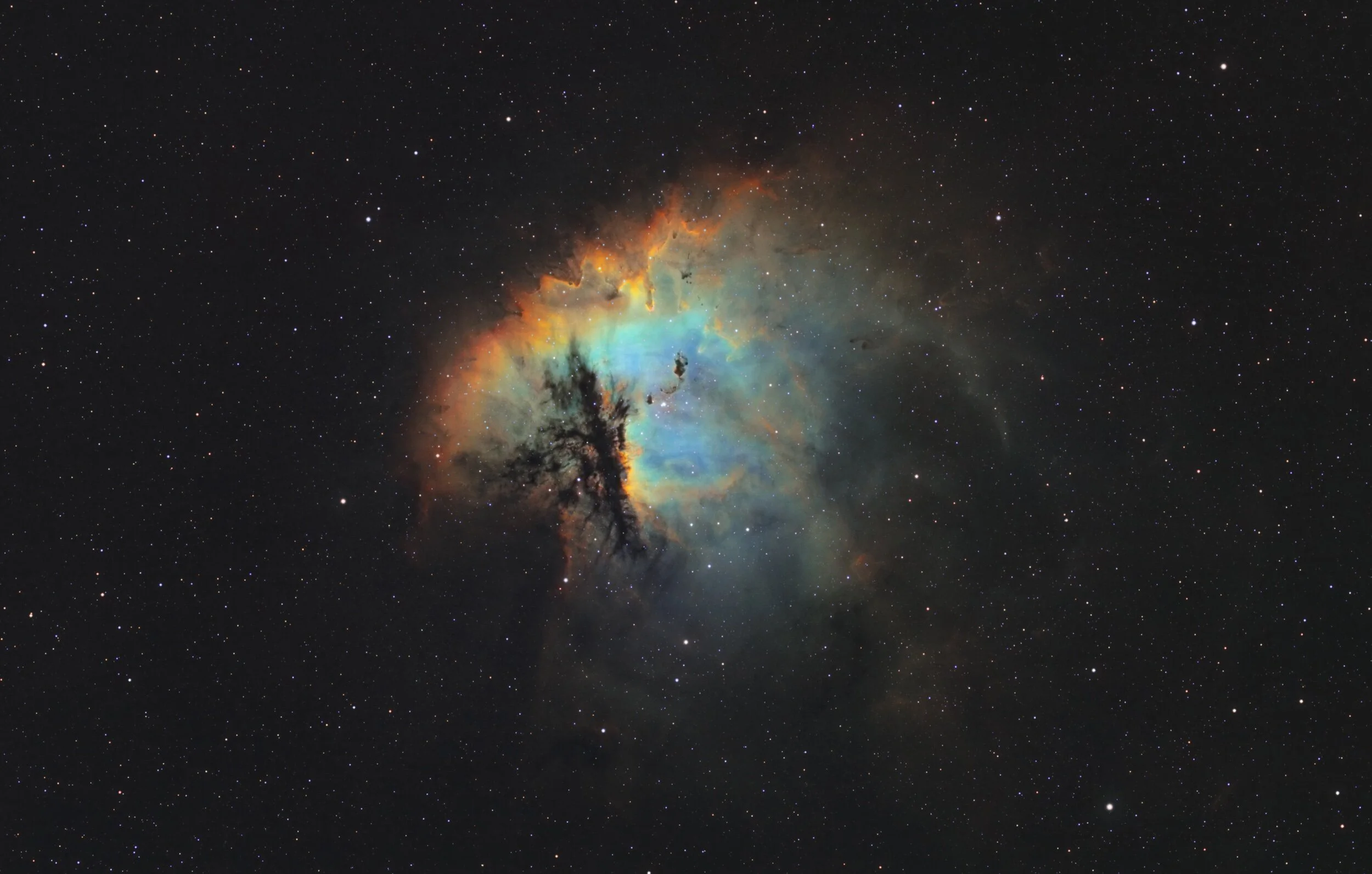
AAPOD2 Image Archives
NGD 6357, NGC 6334, and RCW 133
Image Details:
September 19, 2021
Location: Yass, NSW, Austrlia
Telescope: Takahashi FSQ-106EDX4
Camera: FLI PL16803
Mount: Paramount MX+
Ha: 26x10 minutes (binned 1x1)
OIII: 26x10 minutes (binned 1x1)
SII: 31x10 minutes (binned 1x1)
Copyright 2021 Bernard Miller
The pillar of Cepheus (VdB 152)
Image Description and Details :
This cosmic pillar stretches for approximately 1,400 light years along the northern part of the Milky Way, in the constellation Cepheus. Near the edge of the large molecular cloud, pockets of dust block all light from the stars in the background or weaken the light of the brightest star at the top, this star giving the nebula its characteristic blue color.At the bottom right of the image is a planetary nebula LBN 538 (red / blue). Discovered in 1979 and first described in an article in 1980 by Dengel, Hartl and Weinberger.ASA Newton 250/950 F3.6Paramount MyTZWO ASI2400MC à -10°C + rotateur ArteskyIDAS LPS-P3 et IDAS NBZ Nebula BoostSkywatcher Evostar72ED + ASI120MM miniTheSkyX pro, MaxPilot, FocusMax, AstroPixel Processor, PixInsight, Photoshop44h5' (68x 900” Filtre NBZ, 83x300" et 121x600" Filtre LPS-P3)Lorraine, France31 August, 1er, 2, 3, 4, 5, 7 et 8 September 2021
Copyright: Thomas LELU
The Alpha and Omega
Image Description and Details : This cosmic landscape depicts Sh2-115 and Abell 71, the first an emission nebula and the latter a planetary nebula. Or, in other words, the birth and the death of stars - hardly anything else more meaningfull to us.
Image shot in narrowband, 13 hours in Ha and 22 hours in O3, during July and August 2021, being the last frame of Aug.19th. Equipment as follows:
Telescope: TS PhotoLine Triplet APO 115/800mm
Camera: QHYCCD 163M
Filters: Baader OIII 8.5nm 36mm · Baader Ha 7nm 36mm
Mount: Sky-Watcher EQ6-R Pro · Skywatcher AZ EQ5-GT
Copyright: André Vilhena
M33
Image Description and Details :RECORDING DATA:
Location: Upper Austria
Object: Messier 33
Photo taken in: September 2021
Distance: 2.8 million light years
Diameter: 60,000 light years
Exposure: 203 x 300 sec. For RGB24 x 900 sec. For dual narrow band
Total: 23 hours
Calibration: Darks / Flats / DarkFlats
Mount: Skywatcher EQ6-R PRO
Telescope: Lacerta Fotonewton 250/1000
Corrector: Lacerta GPU coma corrector
Filter: Astronomik L2 UV-IR Block 2 ″ Optolong Filter L-eXtreme 2 ″
Camera: QHY268c @ Gain 0/60 at -15 ° C
Guiding: ZWO OAG with QHY5III462c and PHD2
Software: APP / Photoshop CC
Copyright: Daniel Nimmervoll
Ic 1318
Image Description and Details : IC 1318 taken in South Portugal.
IC 1318 also called the Butterfly Nebula, is a nebula in emission in the constellation Cygnus.
It is a huge nebula in emission, quite bright and distinct, in the shape of a circumflex accent, rather difficult to see, but which appears easily on photographs. It has in its center a dark nebula. It spreads around the bright star Sadr (γ Cygni). It is located in the Milky Way, thus on a background rich in stars.
Equipment:
-FSQ 106 scope on Eq6 Skywatcher Pro mount
-Camera Asi 1600MM
Ha=14H30
O3=10H48
S2=10H
Total Time: 35H
Copyright: Team Aro
NGC 7635 The Bubble Nebula
Image Description and Details : NGC 7635 The Bubble Nebula captured by David Wills at PixelSkies, Castillejar, Spain
Red 583 x 30s
Green 1483 x 30s
Blue 468 x 30s
Ha 74 x 300s
21 hrs 8 mins hours in total.
Equipment used:
Telescope: Celestron 8" Edge HD
Camera: Xpress Trius SX-694 Pro Mono Cooled to -10C (Binned x2)
Image Scale: 0.8
Guiding: OAG
Filters: Astronomik Ha
Mount: iOptron CEM60 "Standard" GOTO Centre Balanced Equatorial Mount
Image Acquisition: Voyager
Observatory control: Lunatico Dragonfly
Stacking and Calibrating: Pixinsight
Processing: Pixinsight 1.8, Photoshop CC
Copyright: David Wills
IMPACT on the planet Jupiter
Image Description and Details : IMPACT on the planet Jupiter
=========================
On 13.09.2021, I made a series of exposures to the transit of the IO satellite over the planet Jupiter.
Towards the end of the observation session, I noticed a large rapid spark in the IR filter, but I did not realize its importance until, the next day, the Brazilian amateur observer José Luis Pereira also discovered it in his captures and
he made it public. The seeing was good that night, but at the time of the impact it had dropped considerably.
Processing was required to combine the exposures made on the IR filter, in which the impact occurs, with the rest of the filters,
green and blue, to achieve a color image. The capture was made with a monochrome ZWO ASI 290MM camera, the exposure video being 2000 x3 frames on each filter.
The derotation of the SER videos was performed in the WinJUPOS program, the total duration being 14 minutes.
Although I am the beginning of the exposures to the planets, being focused on the deepsky pictures, I think I was very lucky to catch this event.
I want to thank Dm. astrophotographer Pepe Mera, for the tips related to the optical part, which have a lot in mind in the realization
exposures to planets.
Clear sky!
Telescope: Celestron Edge HD11
Camera: ZWO ASI 290MM
Fara Barlow
Filters: Optolong IR Pass 685nm filter
Astrodon G, B Gen2 E Tru-Balance filters
Frames: 2000x3x3 (28 fps)
Mount: EQ6R Pro
Processing: AutoStakkert, RegiStax, WinJUPOS, Photoshop
Details Jupiter:
Visual magnitude: -2.8
Diameter: 48.0 "
IO Satellite Diameter: 1,221 "(Visual Mag: 5.1 Mag)
Altitude: 24 °
Azimuth: 35 ° [SW]
Clear sky!
Cosmin Sandu
GAAP Group of Amateur and Professional Astrophotographers
Copyright: Sandu Val Cosmin
Vdb 141
The Ghosts Temple In The Sky (Vdb 141)
Total 29h 55min in 7 nights - L 65x900s, R 57x300s, G 50x300s, B 57x300s (L bin 1x1, RGB bin 2x2). RC250 @ f/5.5, ASI2600MM, CEM60, Astrodon filters
Acquisition : APT - Astro Photography Tool (www.astrophotography.app), PHD2
Processing: PixInsight
The Cepheus constellation part of the sky shows part of the Milky Way that host several star forming regions. One of the molecular clouds which spreads from 600 to around 1400 light years away from Earth and is named Cepheus Flare. Near one of Flare edges is the beautifully formed nebula vdB-141 also known as Sh2-136. “vdB” comes after Sidney van den Bergh who discovered the “dark” nature of the object in 1966. “Sh2”comes after from the second edition of Stewart Sharpless emission nebulae catalog published in 1959. It also has popular name “Ghost Nebula”.
Being part of star forming region means that many things are happening. It is a reflection nebula that shines with the light of several stars embedded in it, most obvious is the one in the central blob. In right dark part there is cone shaped area – this is a Bok globule cataloged as CB230. The Bok globules are dark clouds in process of condensing and forming protostars. CB230 is considered to be producing a binary star system. The same place is also cataloged as Herbig Haro object HH 157. The Herbig Haro objects are nebulae around newborn stars that are formed in the nearby clouds by the ionized gas jets emitted by the young stars. It is an interesting area described in the results of different sky surveys.
Copyright: Ivaylo Stoynov
Sun in h-alpha
Image Description and Details : Mosaic of 6 images to the surface, and 4 images do the prominances.
For each imagem from the mosaic were taken +/- 500 images at 30 fps , stacking the best 80%.
Gear used:
Lunt LS60THa solar telescope
Celestron CG5-GT Mount
ASI120mm camera
Copyright: Samuel Dias Müller
NGC7822
Image Description and Details : NGC 7822 is a Nebula located approximately 3000 light years away in the constellation Cepheus, its size is approximately 10 light years The region includes an object from the Sharpless catalog Sh2-171 and the young star cluster Berkley59.
captured in my backyard
Newton 250/1000
Ioptron cem70
zwo294mm-pro
Antlia Filters
Integration 27h16
Ha 191x240"
OIII 106x240"
SII 112x240"
Copyright: Anthony Husson
HFG1/ Abell 6
Image Description and Details :Heckathorn-Fesen-Gull 1 (HFG1) and Abell 6 are a duo of planetary nebulae from the constellation Cassiopea.
The central star of HFG1 is a 14.5 mag binary star. It leaves behind a gas tail of at least 20 '. She is said to be around 10,000 years old.
The structure of HFG1 presents an arc of a circle opposite the tail, in the direction of movement of the nebula, which suggests that it is a shock wave front of matter interacting with the interstellar medium.
Abell 6 is an example of a bubble-shaped planetary nebula. However, it remains quite faint (Mag = 15). It emits more in OIII than in Ha.
TSA120 and asi294MM
220x 300s Ha
220x 200s OIII
90x 120s RGB ( for stars)
Total around 40h
Copyright: Julien Fabre
NEW DISCOVERY - PaStDr 8 / The Bärenstein Nebula and the Supernova remnant G354-33
Image Description and Details : We are very proud to present Patchick-Strottner-Drechser 8 (PaStDr for short) the latest discovery of our team consisting of Dana Patchick from the US, Xavier Strottner from France and Marcel Drechsler from Germany.
6 MONTHS OF WORK, 68 NIGHTS AT THE CHILESCOPE AND 133 HOURS OF EXPOSURE TIME WERE NECESSARY TO IMAGE THIS EXTREMELY FAINT NEBULA.
Our discovery is a previously unknown potential planetary nebula in the constellation Sagittarius.
The structure has a diameter of almost one degree in the night sky and a distance of about 840 light years to Earth.
The special feature of this photo are the extremely filigree and blood red filaments of the supernova remnant G354-33, which can be seen in the left part of the image. This is the first photo ever taken of this almost unknown supernova remnant. In 2004 G354-33 was mentioned as a possible SNR in a scientific paper. However, with our work we were able to confirm G354-33 as a true SNR.
The scientific paper on this SNR, on which we worked with Professor Robert Fesen of Dartmoor College, can be found here:
https://arxiv.org/pdf/2102.12599.pdf
It is noteworthy that PaStDr 8 does not appear approximately spherical as usual, but appears much brighter and denser in the west (note, in the night sky the west is shown on the right and the east on the left).
We suspect that the structure of this candidate interacts with supernova remnant G354-33 or is distorted by its shock.
Measurement of the distance between the two structures suggests spatial proximity.
Our thanks to Sergey from Chilescope, who strongly supported us with this project.
We would also like to give special thanks to the many donors without whom this costly photograph would never have been possible. Especially the residents of my home community Bärenstein in Germany should be mentioned here, who also supported our project financially. We thank you so much!
Data on the central white dwarf:
- GAIA WD candidate WDJ194511.31-445954.57
- Pwd: 94.2645
- magnitude: 14.42
- Parallax: 3.8190
- Distance: 258 parsecs (+/- 2 parsecs)
- pm (mas/yr): RA -16,368 / -1,400
- Temperature: 8868,67 K
- Ultraviolet: FUV 12.602 / NUV 13.192
Acquisition data
H-alpha : 193 x 1200s (64.3 hours)
OIII : 153 x 1200s (52 hours)
RGB : 16.5 hours (5.5 hours per channel)
total exposure time : 132.8 hours
used telescopes
2 ASA 0.5 Newton (T2 and T3 on Chilescope, parallel operation)
mirror : 500 mm
focal length : 1900 mm
focal ratio : f/3.8
Copyright: Marcel Drechsler
Pillars of Creation
Image Description and Details : Pillars of Creation, zooming into M16 Nebula.
Astrophotography taken with this equipment:
Imaging telescope: Sky-Watcher Espirit 150 ED
Imaging cameras: QHYCCD QHY 16200A
Mounts: Sky-Watcher EQ8-Rh PRO
Software: PHD2 PHD 2 · Photoshop CC PS · Main Sequence Software Seqence Generator Pro · Pixinsight
Filters: Antlia 3.0nm SII PRO · Antlia 3.0nm OIII PRO · Antlia 3.0nm Ha PRO
Frames:
Antlia 3.0nm Ha PRO: 26x900" (6h 30') bin 1x1
Antlia 3.0nm OIII PRO: 24x900" (6h) bin 1x1
Antlia 3.0nm SII PRO: 20x900" (5h) bin 1x1
Total Integration Time: 20 hours
Copyright: Christian Hilbertj
IC 63 - The Ghost of Cassiopeia
Image Description and Details : Scope: Konus 200/1000 reduced @960mm, f4,8
Camera: QHY8L @-10°C, gain 10, offset 113, with coma corrector Tecnosky 0,95x and Optolong L_enhance filter
Guide: Skywatcher 70/500 with Asi120MM and UV/IR-cut filter Svbony
Mount: Skywatcher Eq6r Pro
Management system: Raspberry PI4 with Stellarmate OS remotely controlled with Windows 10
Acquisition software: Kstars/Ekos
Frames: 84x600" calibrated with flat, dark and bias
Post production softwares: AstroPixelProcessor, Pixinsight and Photoshop
Site: Ferrara (Italy), Bortle 6, SQM 19,22
Copyright: Massimo Di Fusco
The northern lights
Image Description and Details : I moved to a small town "Salla" located above the arctic circle in Finland mostly for the auroras and witnessed several big aurora displays on my first month, including this one.
14mm F2.8, 0,4 seconds, ISO 16000
Copyright: Dennis Lehtonen
planetary tour
Grand tour of the outer planets from my backyard. Shot over the last 12 months with the fabulous Astro Physics 10" f/14.5 Mak-cass telescope and the QHY5III-462C color cmos camera. 37 degrees N. 100 ft el. Seeing can be very good at times.
Copyright: John Gleason
Barnard 150 - The Seahorse nebula
Image Description and Details : This dark nebula lies at a distance of 1200 light-years from Earth in the Constellation of Cepheus. Because the nebula is in the Milky Way's plane it stand outs from the background filled with colourful stars of our galaxy, a keen eye can also distinguish three separate dense dust cores that actually are star formation regions.
Taken from my self-made remote observatory in eastern Finland with SkyWatcher Esprit 100mm f/5.5, ZWO ASI1600MM-C, Losmandy G11 guided with ASI224MC as finder-guider, TS Optics LRGB filters.
L: 262x120s, R: 92x120s, G: 100x120s, B: 80x120s.
Total integration time is ~18 hours.
Copyright: © Ville Miettinen
NGC 7582 NGC 7590 NGC 7599
Image Description and Details :
NGC 7582, 7590 and 7599 are an interacting group of galaxies situated 70 million light years away in the constellation of Grus.
Studies in indicate the existence of faint H I bridges between the galaxies.
NGC 7582 at the top right is the brightest galaxy of this trio. It is of interest as it exhibits the characteristics of both a starburst and a Seyfert II spiral galaxy. The starburst activity is quite intense but is localized to several regions.
In 1996 a study indicated that NGC 7582 appears to have two rather than a single nuclei indicating a merger with another galaxy sometime in the distant past.
Imaged in LRGB on our CDK 1000 at El Sauce, Obstech, Chile
Image Processing: Mike Selby
System Control Software : Voyager by Leo Orazi
Integration Time: L 16 hours 900s exp RGB 4 hours each 900s
Copyright: Mike Selby
Ic 1396
Image Description and Details :
Imaging telescopes or lenses: William Optics Star 71mm APO f/4.9
Mounts: CEM60
Guiding telescopes or lenses: William Optics Star 71mm APO f/4.9
Guiding cameras: Starlight Xpress Loadestar X2
Software: PinInsight 1.8 · Main Sequence Software Sequence Generator · PHD2
Filters: Astrodon 36mm Tru-Balance E-Series Green · Astrodon 36mm Tru-Balance E-Series Red · Astrodon H-Alpha 3nm · Astrodon SII 3 nm · Astrodon OIII 3 nm · Astrodon 36mm Tru-Balance E-Series Blue
Accessory: Atik OAG · Moonlite High res stepper motor and Mini-V2 controller · Atik EFW2 Filter Wheel
Dates:Sept. 1, 2021 , Sept. 2, 2021 , Sept. 3, 2021 , Sept. 4, 2021 , Sept. 5, 2021 , Sept. 9, 2021
Frames:
Astrodon 36mm Tru-Balance E-Series Blue: 50x30" (25') -10C bin 1x1
Astrodon 36mm Tru-Balance E-Series Green: 50x30" (25') -10C bin 1x1
Astrodon 36mm Tru-Balance E-Series Red: 44x30" (22') -10C bin 1x1
Astrodon H-Alpha 3nm: 49x900" (12h 15') -10C bin 1x1
Astrodon OIII 3 nm: 6x900" (1h 30') -10C bin 1x1
Astrodon SII 3 nm: 23x900" (5h 45') -10C bin 1x1
Integration: 20h 42'
Avg. Moon age: 22.11 days
Avg. Moon phase: 13.72%
Bortle Dark-Sky Scale: 7.00
Astrometry.net job: 4987700
RA center: 21h 39' 16"
DEC center: +57° 32' 25"
Pixel scale: 3.170 arcsec/pixel
Orientation: 88.298 degrees
Field radius: 1.809 degrees
Resolution: 2460x3290
Locations: Backyard, Charlotte, NC, United States
Data source: Backyard
Copyright: Bradley Craig
NGC281 Pacman Nebula
Image Description and Details : NGC281 Pacman Nebula
Taken in Montréal (Bortle 9)
Around 18h of exposure from 3 nights (the only 3 cleared nights in July/August and early September )
Chroma 3nm SHO
TSA102
QHY294MM
CEM70
Copyright: Jonathan Durand

